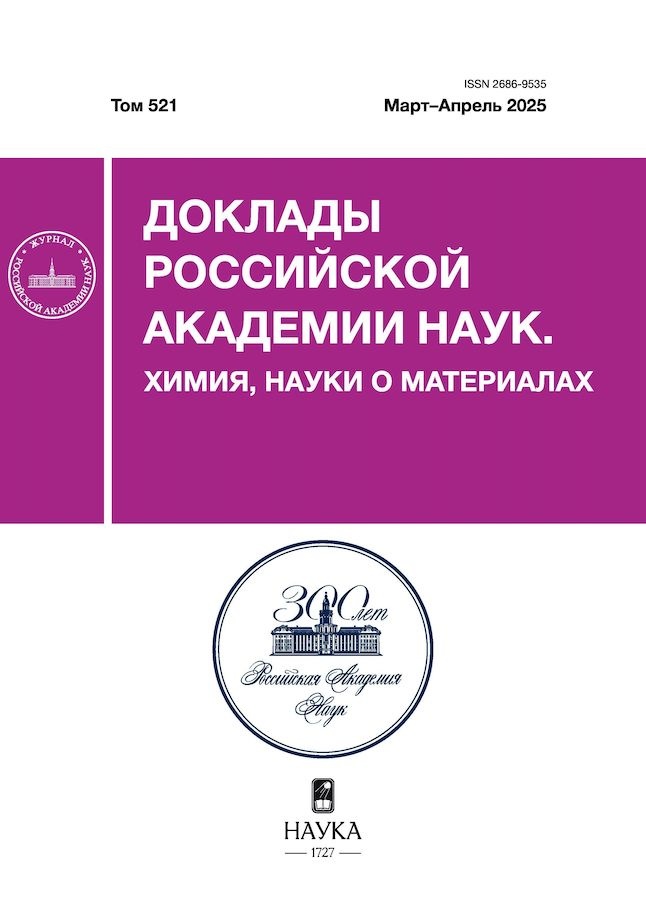Люминесценция комплексов лантанидов в наноанионитах
- Авторы: Королева М.В.1, Ягов В.В.1, Оленин А.Ю.1, Долгоносов А.М.1, Хамизов Р.Х.1
-
Учреждения:
- Институт геохимии и аналитической химии им. В.И. Вернадского Российской академии наук
- Выпуск: Том 518, № 1 (2024)
- Страницы: 41-44
- Раздел: ФИЗИЧЕСКАЯ ХИМИЯ
- URL: https://ter-arkhiv.ru/2686-9535/article/view/680960
- DOI: https://doi.org/10.31857/S2686953524050048
- EDN: https://elibrary.ru/JGSHHV
- ID: 680960
Цитировать
Полный текст
Аннотация
Впервые показана возможность применения наноанионитов в качестве организованной среды для усиления люминесценции комплексов редкоземельных элементов (РЗЭ). При введении золя, образованного наночастицами анионита, в раствор, содержащий теноилтрифторацетон (ТТА) и следовые количества солей европия(III) или самария(III), анионы ТТА концентрируются в фазе ионита и связывают катионы РЗЭ с образованием отрицательно заряженных комплексов, что сопровождается повышением интенсивности люминесценции на три порядка величины.
Полный текст
Об авторах
М. В. Королева
Институт геохимии и аналитической химии им. В.И. Вернадского Российской академии наук
Email: olenin@geokhi.ru
Россия, 119991, Москва
В. В. Ягов
Институт геохимии и аналитической химии им. В.И. Вернадского Российской академии наук
Email: olenin@geokhi.ru
Россия, 119991, Москва
А. Ю. Оленин
Институт геохимии и аналитической химии им. В.И. Вернадского Российской академии наук
Автор, ответственный за переписку.
Email: olenin@geokhi.ru
Россия, 119991, Москва
А. М. Долгоносов
Институт геохимии и аналитической химии им. В.И. Вернадского Российской академии наук
Email: olenin@geokhi.ru
Россия, 119991, Москва
Р. Х. Хамизов
Институт геохимии и аналитической химии им. В.И. Вернадского Российской академии наук
Email: olenin@geokhi.ru
Россия, 119991, Москва
Список литературы
- Полуэктов Н.С., Кононенко Л.И., Ефрюшина Н.П., Бельтюкова С.В. Спектрофотометрические и люминесцентные методы определения лантаноидов. Пилипенко А.Т. (ред.). Киев: Наукова думка, 1989. 256 с.
- Проблемы аналитической химии. Т. 20. Нанообъекты и нанотехнологии в химическом анализе. Штыков С.Н. (ред.). М.: Наука. 2015. 430 с.
- Долгоносов А.М., Хамизов Р.Х., Колотилина Н.К., Шайхина С.У., Евстигнеева П.В. // Сорб. хром. проц. 2016. Т. 16. № 4. С. 400–414.
- Долгоносов А.М., Хамизов Р.Х., Колотилина Н.К. // Журн. аналит. хим. 2019. Т. 74. № 4. С. 285–296. http s://doi.org/10.1134/S0044450219030034
- Nehra K., Dalal A., Hooda A., Bhagwan S., Saini R.K., Mari B., Kumar S., Singh D. // J. Mol. Struct. 2022. V. 1249. Art. 131531. http s://doi.org/10.1016/j.molstruc.2021.131531
- Blois L., Carneiro N.A., Longo R.L., Costa I.F., Paolini T.B., Brito H.F., Malta O.L. // Опт. спектроск. 2022. Т. 130. № 1. С. 207–214. http s://doi.org/10.21883/OS.2022.01.51909.35-21
- Atanassova M. // Separations. 2022. V. 9. № 6. Art. 154. http s://doi.org/10.3390/separations9060154
Дополнительные файлы
















